
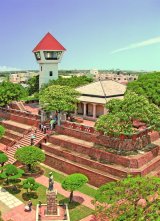
●Visitor's Guide
Adult ticket: NT$ 50; Half-price ticket: NT$ 25
Opening hours: Summer (April to September) 8:00 AM to 6:00 PM
Winter (October to March) 8:30 AM to 5:30 PM
Enquiry line for monuments: 886-6-390-1341 or 886-6-295-5703
Direct line for Anping Fort: 886-6-226-7348
Address: No. 82, Guosheng Road, Anping District, Tainan City
●History of Establishment
In the early seventeenth century, the Dutch formed a team of military and business personnel to make exploratory voyages in Asia for the purpose of establishing an overseas colonial empire. They occupied Anping in 1624, and built Fort Zeelandia as a base for defense. The whole project was completed in 1634. In the sixteenth year of the Yongli period in Ming Dynasty (1662), Koxinga took over the Dutch fort and renamed it as Anping Township. The inner city was changed to be the governor's office, so the Taiwanese called it the King City (Wangcheng). During the Qing Dynasty, Anping area lost its predominance because Taijiang Lagoon was blocked with deposits of silt and mud and gradually became a land. Furthermore, the Qing army destroyed Fort Zeelandia and built Eternal Golden Castel. So this area was gradually abandoned with time. It was rebuilt during the Japanese era. After the retrocession of Taiwan, it was renamed: "Anping Fort". Currently the only remains of the Dutch era are located on the south brick walls of the outer city in front of the old castle. The old banyan tree witness to its rises and falls history in Taijiang area over the past three hundreds years.
●History of Fort Zeelandia
1624 The city, Orange, was built on the rock of former Kunshen. Due to lack of bricks and stones, it was built with sand and wood.
1627 The city was renamed Fort Zeelandia and was gradually completed with bricks and stones.
1633 The construction of Fort Zeelandia was completed; it became early Taiwan City. The city was 2,270.33 meters wide and 30 meters high. It had 3 levels with inner and outer part.
1662 Zheng Chenggong took over Fort Zeelandia and renamed it Anping Township. The inner city was changed to the governor's office. Zheng Chenggong, later granted the title “Prince of Yanping” by Longwu Emperor of Ming Dynasty, lived here for five months and passed away. Therefore, the Taiwanese called it the King City (Wangcheng).
1823 Taijiang Lagoon was blocked with deposits of silt and mud, and gradually became a land.
The King City lost its geographical predominance.
1874 The Japanese invaded Taiwan due to the Mudan Incident. The Qing Government sent Shen Baozhen to Taiwan to organize defense affairs.
1895 Taiwan was ceded to Japan. The Japanese Government set an Anping sub-district office under Tainan district.
1897 The Anping Customs needed a land for accommodations, so the Japanese razed part of Fort Zeelandia and built three-level brick stages on it.
1908 The round white iron-hull lighthouse, which was built during the Guangxu period of Qing Dynasty at Anping port, was moved to the northwest side of the stage with a guard. The lighthouse flashed every four second to guide the ships at sea.
1930 The Office of the Governor-General (Sotokufu) of Japan dismantled the accommodations around the brick stages in order to celebrate "Three Hundred Years of Taiwan Culture". The Japanese altered the accommodations to build a venue for exhibition and entertaining the guests. It is now the Historic Exhibition Hall of Anping Fort.
1935 According to the site map of Zeelandia drawn by Shunichi Kuriyama, the Japanese purchased the houses currently located on the west of Zeelandia Museum and demolished them for large-scale excavation. They found the fort base of angular-shaped bastion in the southwest of the city. The excavation project stopped due to the Sino-Japanese War.
1975 Following the Tourism Year Project, Tainan City Government renovated the surrounding area of the fort. A sharp-shaped roof was built on the watchtower and the walls were painted in white. This is the extant building of Anping Fort.
Anping Treehouse
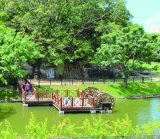
●Visitor's Guide
Adult ticket: NT$ 50; Half-price ticket: NT$ 25
Opening hours: Summer (April to September) 8:00 AM to 6:00 PM
Winter (October to March) 8:30 AM to 5:30 PM
Enquiry line for monuments: 886-6-390-1341 or 886-6-295-5703
Direct line for Anping Treehouse: 886-6-391-3901
Address: No.108, Gubao Street, Anping District, Tainan City
●History of Foreign Trade in Taiwan
Anping was the earliest port in the history of Taiwan. It was the main trading port during the Dutch era, Ming Zheng period, Qing Dynasty, and Japanese era. In the eighth year of the Xianfeng period in Qing Dynasty (1858), Treaty of Tianjin was signed which stipulated that Taiwan would open its ports for trade. Tamsui and Quelang were opened first and then Tagau (now Kaohsiung) and Taiwan Prefecture (now Tainan). Anping was opened in the third year of the Tongzhi period in Qing Dynasty (January 1, 1865), and thereafter foreign merchants came to set up companies and engaged in business. The British companies, Tait & Co., Elles & Co., Boyd & Co., together with the American company, Wright & Co. and the German company, Julius Mannich & Co., were known as "the top five trading companies in Anping". During the Japanese era, the opium was monopolized by the Japanese and the shipping business was also taken over by them. Therefore, these foreign trading companies left Anping. The buildings of these trading companies were gradually rebuilt or used for other purposes. Wright & Co. was changed to Osaka Shosen Kaisha (OSK). Julius Mannich & Co. was changed to Anping sub-district office. Elles & Co. was changed to Anping Marine and Fishery School. Boyd & Co. was changed to the staff housing of TAIYEN (Taiwan Salt Manufacturing Company). The building of Tait & Co. was sold to Taiwan Salt Manufacturing Company. After the retrocession of Taiwan, the building of Tait & Co. was used as an office and taken over by Taiwan Salt Works (previously known as Taiwan Salt Manufacturing Company). After Taiwan Salt Manufacturing Company moved to another place, the building was changed to the "Wax Museum of Taiwan Development" in 1979. It was designed by the Tainan City Government and donated by Chi Mei Culture Foundation. Tait & Co. and Julius Mannich & Co. are the only two buildings of merchant houses remaining. They bear witness to the history of foreign trade in Taiwan of Qing Dynasty.
●History of Anping Treehouse(Old Tait & Co. Merchant House)
1865 The customs was set up in Anping and the port was officially opened. Foreign companies established their trading companies one after another. Suddenly foreign companies and merchant houses were everywhere.
1867 The British company, Tait & Co. Merchant House, was established in Haitoushe, Anping. It mainly engaged in block trade, such as opium, camphor and sugar. Together with Elles & Co., Boyd & Co., Wright & Co. and Julius Mannich & Co., Tait & Co. was known as one of "the top five trading companies in Anping".
1895 When Japan was in charge of Taiwan, the Japanese government took over the trading rights of opium and camphor. The business of the trading companies decreased rapidly. Furthermore, the Anping port was silted up increasingly which affected loading and unloading ships. These trading companies were closed gradually; only Tait & Co. Merchant House still operated.
1911 After these trading companies in Anping closed down one after another, the Japanese changed them into salt industry companies. After World War II, they were changed to offices of Taiwan Salt Works in Tainan.
1979 Tainan City Government took over the Tait & Co. Merchant House and renovated it. It is now the Wax Museum of Taiwan Development.
2001 The Treehouse was opened for artists to exhibit their works. The renovation work of the Treehouse was conducted in three stages, and it became the back garden for Tainan City.
National Historic Monument Fort Provintia ChihkanTower
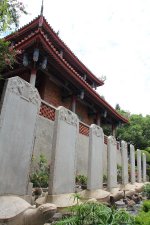
●Visitor's Guide
Adult ticket: NTD 50; Half-price ticket: NTD 25
Opening hours: Summer (April to September) 8:00 AM to 9:30 PM
Winter (October to March) 8:30 AM to 9:30 PM
Enquiry line for monuments: 886-6-390-1341 or 886-6-295-5703
Direct line forChihkan Tower: 886-6-220-5647
Address: No.212, Sec. 2, Minzu Road, West Central District, TainanCity
●History of Establishment
It was built by the Dutch who occupied southern Taiwan duringthe seventh year of the YongliPeriod in Ming Dynasty (1653). Originally it was called "FortProvintia". "Fort Provintia" and "FortZeelandia" in Anpingwere two oppositecorners of the city. FortZeelandiawas the center of the Dutch government andFortProvintia was the center of administrationand commerce.
FortProvintia is formed by three square terraces with western buildings built above each terrace. Syrup andglutinous ricejuice mixed with oyster shell ash were used to bond the walls, which were mainly built with red bricks. It is solid as rock. Even after threehundred years, the ancient structure is still visible through the thick walls and arches.
With a history of over threehundredyears, theChihkan Towernowadays is roofed in red tiles with cornices, like a towering castle. In the vicissitudes of history, it was once the western style castle of the Dutch era, the Chinese pavilion of Qing Dynasty, and the army hospital of the Japanese era; nowadays, it’s a historical museum. Chihkan Towerbears witness to a history of glory and decline.
The Ministry of the Interior ranked it as a first-class national monumentin 1983.
●History of Fort Provintia (Chihkan Tower)
1625 The Dutch used fifteen bolts of cloth to exchange the land of Chihkan area with the aborigines. They built shops, streets, warehouses and hospitals here, and named Provintiaas street's name.
1653 Due to the GuoHuaiyi Rebellion, the Dutch built a castle in Chihkan fordefense and also as a commercial and administrative center. The Dutch called it "FortProvintia". It has also been called "Fort San Domingo" or"Fanzailou", and later"Chihkan Tower".
1862 The already damaged Dutch architecture built above the Chihkan Tower collapsed due to an earthquake that severely affectedsouth-central Taiwan.
1875 ShenBaozhen led the army to Taiwan due to the Mudan Incident. He petitioned for building the Sea God Temple on the relic of the Chihkan Tower for the purpose of praying forsailing safety. However, the project was delayed and had not been completed.
1886 The Taiwanese magistrate, ShenShouqian, built "Penghu College" in the west side of the ChihkanTower for revitalizing culture and education. He also built Wuzih Temple (Five Confucian Scholars Templeworshipping the Confucian scholars of the Song Dynasty: Zhu Xi, Cheng Hao, Cheng Yi, Zhang Zai and Zhou Dunyi) on the relic of the castle base. Furthermore, he built "Wunchang Pavilion" and rebuilt the Sea God Temple.
1895 The Japanese era began. TheChihkan Tower was changed to "Wei Shu Army Hospital" (Former Japanese Military Hospital).
1944 The Japanese began to renovate the relics of the Dutch castle. They demolished the Dashin Temple (Bodhisattva Hall), renovated the Sea God Temple, the Wunchang Pavilion and the lobby of Penghu College.
1960 The former Imperial Bisi Stele (a tortoise-mounted stele, Yu BisiBeizuo) was moved from Great South Gate to the south of the Chihkan Tower base.
1965 The Chihkan Tower was renovated. Reinforced concrete was used to replace the woodenframe of the Sea God Temple and the Wunchang Pavilion. However, the buildings still had imitative wooden pillars and beams. The entrance ofthe Wunchang Pavilion was moved from Chihkan Street to Minzu Road.
Koxinga Shrine
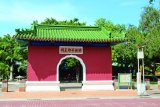
●Visitor's guide
Opening hours: Summer (April to September) 8:00 AM to 6:00 PM
Winter (October to March) 8:30 AM to 5:30 PM
Enquiry line for monuments: 886-6-390-1341 or 886-6-295-5703
Direct line for Koxinga Shrine: 886-6-213-5518
Address: No.152, Kaishan Road, West Central District, Tainan City
●History of Establishment
The shrine was built in memory of Kaitai Shengwang, Koxinga (the founder of first Chinese regime in Taiwan), Zheng Chenggong, after the sixteenth year of the Yongli Period in Ming Dynasty (1662). After the fall of the Ming Cheng Monarch era, people still felt gratitude to Koxinga for retrieving Taiwan from the Dutch and developing the country. The shrine was called Kaishanwang Temple. Afterward it was expanded and rebuilt but soon collapsed. In the thirteenth year of Emperor Tongzhi in Qing Dynasty (1874), Shen Baozhen came to Taiwan for organizing defense affairs due to the Mudan Incident. He requested for giving a posthumous honorific title for Koxinga and building the shrine. Kaishanwang Temple then changed to Koxinga Shrine and had ceremonies in spring and autumn. In the twenty-first year of Emperor Guangxu in Qing Dynasty (1895), the Japanese occupied Taiwan and rebuilt the shrine as Kaishan Shrine in order to promote the spirit of Koxinga 's patriotism and loyalty. The Japanese used the example that Koxinga had a blood relationship with the Japanese to emphasize Hua–Yi distinction. The shrine was rebuilt in 1963 and the main ceremony was approved to be held on April 29.
●History of Koxinga (Zheng Chenggong)
1624 He was born in Hirado-shi Island of Hizen province in Kyushu, Japan, in the fourth year of the Tianqi period of Emperor Xizong in Ming Dynasty. His mother was a Japanese lady, Tagawa Matsu.
1630 When he was seven years old, he was sent back to China from Japan in the third year of Emperor Chongzhen in Ming Dynasty. He looked straight in appearance and his father Zheng Zhilong named him Zheng Sen.
1645 He was granted an audience with the Emperor Longwu in the first year of Hungkuang period in Ming Dynasty. He was also given the imperial surname and renamed Chenggong as well as assigned as the Military Commander Zhongjun Dudo and granted an imperial sword. At that time people called him "Koxinga" (Father of the Nation Name or Lord of the Imperial Surname).
1646 He was granted the Great General of Imperial Zhaotao by the Emperor Longwu in the first year of Longwu period in Ming Dynasty. In August, Fuzhou fell into enemy hands and Prince Tang was captured. Prince Tang died after his hunger strike. Koxinga 's father, Zheng Zhilong, was escorted to Beijing and his mother committed suicide.
1647 He went to the Confucius Temple and burned his Confucian clothes (costume worn by a Confucian scholar) in the first year of Yongli period in Ming Dynasty. He joined the army and determined to campaign against Qing Dynasty and to retrieve Ming Dynasty. He recruited troops in Lieyu (Small Kinmen) against Qing military forces. Prince Guei succeeded to the throne and set era named as Yongli.
1649 In the third year of Yongli period, Koxinga was conferred the title of "Weiyuan Hou". He took Kinmen and Xiamen as the bases for campaigning against the Qing military forces.
1658 He was awarded as Duke Yanping (Yanping Wang) by Prince Guei. He led his troops and went northward from Xiamen on May 13 of the twelfth year of Yongli period.
1661 On March 23, he led his army from Liaoluo Bay and went eastward to conquer Taiwan.
1662 The Dutch surrendered and left Taiwan. The thirty-eight years of Dutch reign (1624-1662) was over. Koxinga established Chengtian Fu as the administrative center in Chihkan, Tainan, set Tianxing and Wannian counties and assigned the magistrates in charge of county affairs. He also named Taiwan as "Dong Du" (East Capital), renamed Zeelandia as "Anping Township" and set Anfu Sih (a defense bureau) in Penghu. He introduced traditional Han Chinese laws and institutions to Taiwan. He did not accomplish his campaign against Qing Dynasty and died at the age of 39 on May 8 in Anping.
1875 In the first year of Guangxu, Shen Baozhen requested for giving a posthumous honorific title for Koxinga and building the shrine. The Qing Government approved the establishment of the shrine in Taiwan Province and honored his "loyalty and integrity". The authority then changed Kaishanwang Temple to Koxinga Shrine.
2008 In this year, the Tainan City Government moved Kaitai Shengwang Statue "Tongxinjing" from Kaishanwang Temple to the hall of Koxinga Shrine and restored the incense exceptionally. It united the space of "temple" and "shrine" for worship.
2010 In this year, two Kaitai Shengwang Statues, "Chengxinjing" and "Hexinjing" were also moved to Koxinga Shrine. The three Kaitai Shengwang Statues had been all moved to Koxinga Shrine for worship, being the ancestral temples of Koxinga in Taiwan.
National Historic Monument Eternal Golden Castle
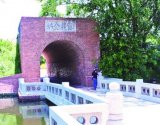
●Visitor's Guide
Adult ticket: NT$50; Half-price ticket: NT$ 25
Opening hours: Summer (April to September) 8:00 AM to 6:00 PM
Winter (October to March) 8:30 AM to 5:30 PM
Enquiry line for monuments: 866-6-390-1341 or 866-6-295-5703
Direct line for Eternal Golden Castle: 866-6-295-1504
Address: No. 3, Guangzhou Road, Anping District, Tainan City
Cultural Affairs Bureau, Tainan City Government Advertisement
●History of Establishment
In the thirteenth year of the Tongzhi period in Qing Dynasty (1874), the Japanese invaded Taiwan due to the Mudan Incident. The Qing government sent Shen Baozhen to Taiwan to organize defense affairs, along with delegates to negotiate with Japan to withdraw their troops. Meanwhile, Shen Baozhen also actively strengthened the defense force of Taiwan. To protect the coast of Anping and Taiwan Prefecture, Shen built the fort with the bricks from Fort Zeelandia and Western-style red bricks. The fort was surrounded by moat with seawater perfusion. It was ten meters wide with a deep moat. The access gate for the fort opened toward southeast.
The fort was completed in the second year of Guangxu period in Qing Dynasty (1876). It was not only the first modern western style fort in Taiwan but also equipped with 5 powerful British-made 18-ton RML Armstrong Guns. There was a concrete house about two meters thick under the fort and it was used as an artillery shelter and a warehouse. It was destroyed and now replaced by the slope cover with soil. In the beginning of twentieth century, the large artillery was destroyed and sold. The wooden bridge collapsed and the holes in the walls were filled with bricks. The landscape was fragmented and broken. In 1975 was the 100th anniversary of the establishment of the fort. Tainan City Government extensively renovated the fort and imitated the large-, medium- and small-sized artillery. The current appearance of the fort is the result of the renovation at that time.
●History of Eternal Golden Castle
1874 A fishing boat from Ryukyuan, drifted to Mudan area of Taiwan and the fishermen on the boat were killed by the aborigines in Taiwan. It was known as the Mudan Inccident and used as the excuse for the Japanese military to invade the current Pingtung area in Taiwan. The Qing Government assigned the shipping minister of Fujian, Shen Baozhen as an imperial envoy to organize defense affairs in Taiwan. Shen Baozhen started to build the Erkunshen Artillery Fort in September.
1876 The first western style fort in Taiwan was finally completed with the title, "Eternal Golden Castle" on the wall. Since then it has carried on the mission to protect the territory of Kunshen coast of Anping area.
1905 During the Japanese era, the fort had been destroyed several times. After Taiwan's retrocession, the government extensively renovated the fort in 1975 to celebrate the 100th anniversary of the establishment of the fort. The current appearance of the fort is the result of the renovation at that time.
1999 The fort was renovated again and reopened in 1999. During the last renovation, excavation led to the discovery of some buried relics, which have been protected with glass for exhibition now.